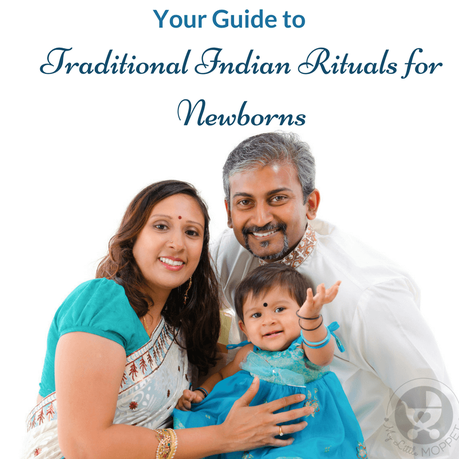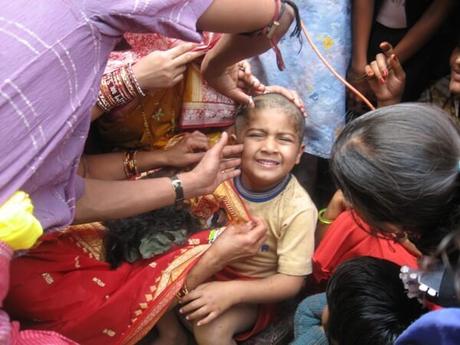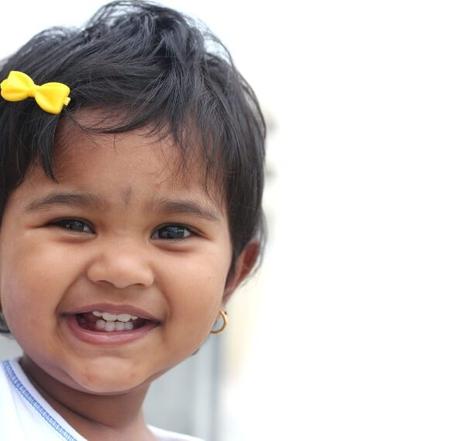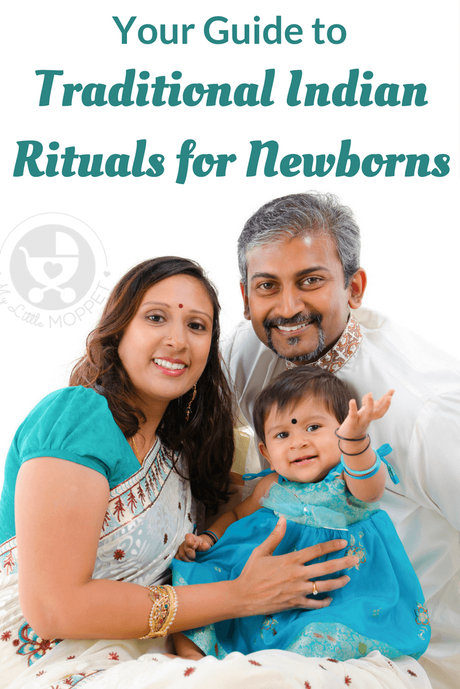November 23, 2017 Leave a Comment
Share Tweet Pin +1Shares 0We live in a country that has so many traditions it’s hard to keep count! With so many different languages, cultures, religions and geographies, it’s not really that surprising. Yet, there are many rituals that are common, especially when it comes to pregnancy and child care. For instance, nearly every culture or region has some kind of ceremony during the 7th/8th month of pregnancy. Similarly, there are many rituals when the baby is born. Since looking at every single Indian tradition or ritual will be an exhaustive process, we’ve picked the top 3 – the most common traditional Indian rituals for newborns today.
Your Guide to Traditional Indian Rituals for Newborns

Shaving the head (Mundan)

This is probably the most common ritual done for newborns in India – across religions and states! The reason for doing this depends upon each specific family. While some reasons are spiritual in nature, some are more practical. One common reason parents shave their newborn’s head is to encourage the growth of thick hair.
From a scientific perspective, there is nothing wrong in shaving the baby’s head, but it is unlikely to increase hair growth. Hair grows from follicles under the scalp, and shaving the head does not affect these. As the new hair grows, it may appear to be thicker than before, but in reality there’s unlikely to be any significant difference.
Things to Consider:
- Time this ritual when the baby is at least 1 month old; never before that. Younger babies skin may be too delicate to handle the rigors of shaving.
- Choose the time of day when baby is most relaxed; when he has been fed and bathed.
- Ensure that the person doing the shaving is experienced enough.
- Lather baby’s hair with baby shampoo.
- For very small babies, it’s better to do the shaving in short spurts, taking breaks to feed the baby in between.
- Bathe the baby after shaving and apply disinfectant over her scalp.
- Apply moisturizer regularly to the scalp to prevent itchiness and drying.
Ear Piercing

Ear piercing is another commonly done baby ritual across all regions and religions. While its mostly girls’ ears that are pierced, in some cultures boys’ ears are also pierced. For some the reasons are religious, while for others it’s just cosmetic.
Ear piercing, if not done correctly, can lead to many complications. When you decide to pierce your baby’s ears may depend upon your customs, but it is generally recommended to wait till the baby’s at least a year old. Younger babies have more delicate skin and are more prone to infections that may result from the piercing. Another problem is that since the ear lobes are so tiny, the placement of the piercing can be a problem, which means that you could end up with asymmetrical piercings on either side.
Things to Consider:
- Before getting your baby’s ears pierced, have a talk with your pediatrician. Your doctor may recommend a date based on the baby’s age and her vaccination schedule. He may also prescribe any mild anesthetic if needed.
- It’s best to get your baby’s piercing done at a certified place or a doctor’s clinic. They are more likely to have latest equipment and follow the strictest hygiene standards.
- A piercing gun is the best way to pierce your baby’s ears – it’s quick, efficient and the least painful. Whatever method you choose, ensure that the equipment is completely sterilized and the person doing it is wearing sterile gloves.
- Choose a time of day when your baby is the most relaxed, a time when she is well rested and well fed. Take along a toy or book to distract baby.
- Choosing the right earrings is very important. Ensure that all parts (front, back, rod) are made of an allergy-free material. Very tiny studs may get into the pierced hole and cause infections. Hoops are not advisable for young children as they may pull on them.
- Be very sure that the earrings are tightly fixed on, while allowing enough space for air to circulate and for the hole to heal. Loose earrings can fall off and pose a choking hazard.
- Follow your pediatrician’s instructions regarding post-piercing care. Don’t change the earrings till the healing period is over, around 6 weeks.
Circumcision

Circumcision is a medical procedure that involves removing the foreskin. It’s a ritual that’s not as common as head shaving or ear piercing in India, and it is often done for religious or medical reasons. Again, there are wide variations on when and how it is done, depending upon where you live.
From a medical perspective, circumcision can lower the risks of urinary tract infections, penile cancer and even STDs in the future. It also makes hygiene easier, preventing the growth of bacteria and viruses. However, circumcision also has its risks, like bleeding, adhesions or infections, especially when the procedure is not carried out correctly.
Things to Consider:
- For circumcision, earlier is better, and many hospitals perform the procedure before the newborn even leaves the hospital. The reasons are that the foreskin is much thinner and the baby is not old enough to roll over and hurt himself. It also heals faster than when done later.
- Circumcision is a procedure that has to be done at a hospital by a trained medical professional. The baby may require an anesthetic cream or injection to handle the pain.
- After care is very important for circumcisions. It is recommended to keep the area as dry as possible till it heals completely, around 1 to 2 weeks in newborns.
- Some doctors recommend leaving the baby diaper free for the first few days. Discuss the matter with your doctor to find a solution that works for you.
- Keep the circumcised area clean, especially after the baby has had a bowel movement.
Like we mentioned earlier, these are just the top three traditional Indian rituals for newborns, and there are many, many more! Remember that these are very basic guidelines that apply for babies who don’t have any other complications. If your baby is premature or has any kind of health condition, please discuss each step in detail with your pediatrician. You may have to carry out the rituals a little later than other babies his age, but that’s okay! As every Mom knows, what’s important is that our babies are safe, healthy and happy – even while following traditions!

Want to see videos of our recipes ?
VISIT OUR YOUTUBE CHANNEL Share Tweet Pin +1Shares 0
Filed Under: Grooming, Health, Parenting Tagged With: babies, baby, baby care, circumcision, ear piercing, grooming, health, health tips, newborns, rituals, shaving head
